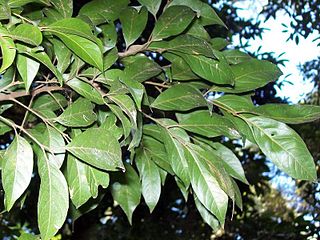
Cupaniopsis is a genus of about 67 species of trees and shrubs of the soapberry family, Sapindaceae. They grow naturally in New Guinea, New Caledonia, Australia, Torres Strait Islands, Fiji, Samoa, Sulawesi, Micronesia. Many species have been threatened with extinction globally or nationally, with official recognition by the International Union for Conservation of Nature (IUCN) and several national and state governments.

Harpullia is a genus of about 27 species of small to medium-sized rainforest trees from the family Sapindaceae. They have a wide distribution ranging from India eastwards through Malesia, Papuasia and Australasia to the Pacific Islands. They grow naturally usually in or on the margins of rainforests or associated vegetation.

Jagera is a genus of 4 species of forest trees known to science, constituting part of the plant family Sapindaceae.

Diploglottis is a genus of 10 species of trees known to science, constituting part of the plant family Sapindaceae. They grow naturally in rainforests and margins of adjoining humid forests in eastern Australia and New Guinea. Some species are known as native tamarind or small-leaved tamarind; they have no direct relationship with the true tamarind.

Arytera is a genus of about twenty–eight species known to science, of trees and shrubs and constituting part of the plant family Sapindaceae. They grow naturally in New Guinea, Indonesia, New Caledonia, Australia, the Solomon Islands, Vanuatu, Fiji, Samoa, Tonga; and the most widespread species and type species A. littoralis grows throughout Malesia and across Southeast Asia, from NE. India, southern China, Borneo, Malaysia, Singapore, Indonesia and the Philippines to as far east as New Guinea and the Solomon Islands.

Atalaya is a genus of eighteen species of trees and shrubs of the plant family Sapindaceae. As of 2013 fourteen species grow naturally in Australia and in neighbouring New Guinea only one endemic species is known to science. Three species are known growing naturally in southern Africa, including two species endemic to South Africa and one species in South Africa, Eswatini and Mozambique.

Elattostachys is a genus of about 21 species of trees known to science, constituting part of the plant family Sapindaceae.

Lepiderema is a genus of nine species of trees from the family Sapindaceae. As of November 2013 botanists know of seven species growing naturally in Australia and two species in New Guinea. Published botanical science provides a limited knowledge of the full range of diversity in Australia and especially in New Guinea. In New Guinea the two known species have descriptions based each on only a single type specimen collection. Therefore, collection of more specimens and more species is most likely in New Guinea. In Australia they grow in rainforests of the northern half of the east coast side of the Great Dividing Range, from northeastern New South Wales through to northeastern Queensland.

Mischocarpus is a genus of about nineteen species of trees known to science, constituting part of the plant family Sapindaceae. They grow naturally from Australia and New Guinea, though Malesia as far north as the Philippines, through SE. Asia, Indo-China and S. China, to India at their farthest west. The eleven Australian species known to science grow naturally in the rainforests of the eastern coastal zone of New South Wales and Queensland, from Newcastle northwards through to north-eastern Queensland and Cape York Peninsula.

Jagera pseudorhus, commonly named foambark, is a species of rainforest trees, in the northern half of eastern Australia and in New Guinea, constituting part of the flowering plant family Sapindaceae. Named for the saponin foam that forms on the bark after heavy rain.

Trochocarpa is a genus of shrubs or small trees, of the plant family Ericaceae. They occur naturally through coastal and montane eastern Australian rainforests and mountain shrublands and in New Guinea, Borneo and Sulawesi (Malesia).

Sarcopteryx is a genus of about 12 rainforest tree species known to science, of the plant family Sapindaceae. They occur in Australia, New Guinea and the Moluccas.
Tristiropsis is a genus of about 14 flowering trees species, of the plant family Sapindaceae.

Mischarytera is a genus of rainforest trees, constituting part of the plant family Sapindaceae. Four species are known to science as of December 2013, found growing naturally in eastern Queensland, Australia, and in New Guinea. Formerly until 1995, they had names within the genus Arytera, subgenus Mischarytera.

Sarcotoechia is a genus of tropical rainforest trees, constituting part of the plant family Sapindaceae.

Synima is a genus of tropical rainforest trees, constituting part of the plant family Sapindaceae.
Lepidopetalum is a genus of six species of trees known to science, constituting part of the plant family Sapindaceae.
Cnesmocarpon is a genus of 4 species of rainforest trees known to science, constituting part of the plant family Sapindaceae.
Dictyoneura is a genus of two-to-three species of rainforest trees known to science, constituting part of the plant family Sapindaceae.

Alectryon connatus, sometimes named hairy alectryon, is a species of small tree in the plant family Sapindaceae.



















